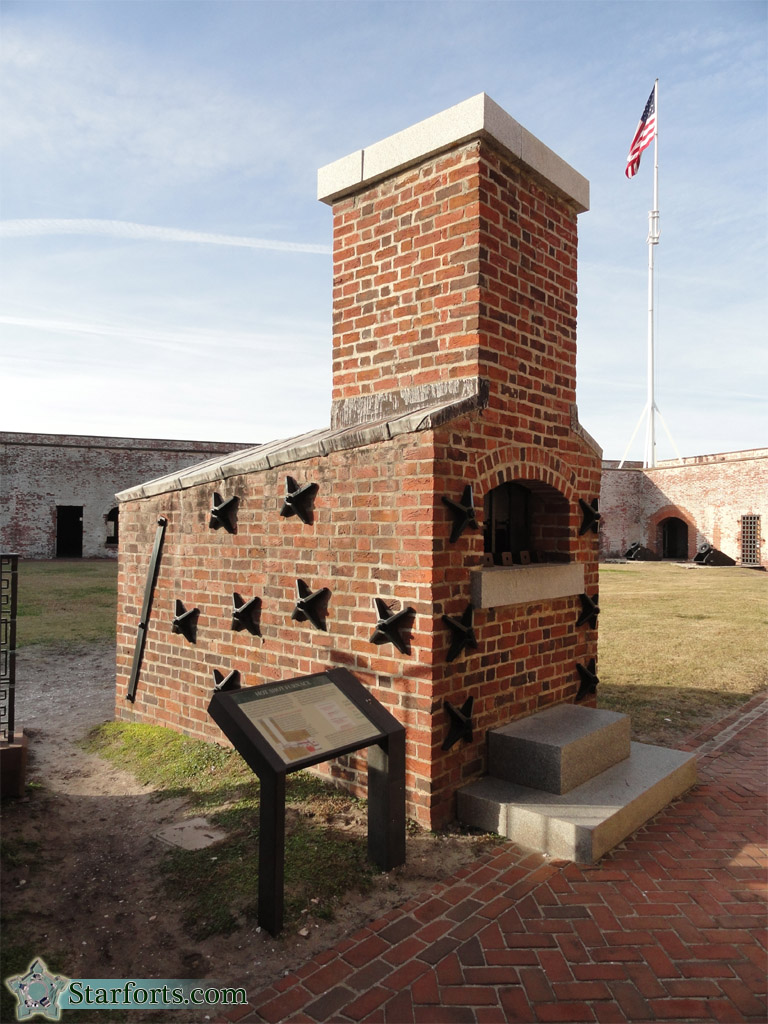

A replica of Fort Macon's Hot Shot Furnace, which was built on the foundations of one of the fort's two such furnaces, which were originally built in 1836. The other Hot Shot Furnace was outside the fort's walls.
Inside this furnace, non-explosive cannonballs were heated to a red-hot condition, at which point they would be somewhat awkwardly (and quickly) transported to a cannon, into which clay or wet hay would have been packed against the gunpowder charge...this would prevent the cannon from firing the instant the red-hot cannonball hit the gunpowder, doubtless shearing off (but instantly cauterizing, so no big deal) whatever wayward body part a loader might have carelessly left in the way of the muzzle.
The concept was that, by firing a red-hot ball of iron into the planks of a wooden ship, that offending ship would whoosh instantly into flame, which sailors of wooden ships generally found disruptive to most nautical endeavors.
Both of Fort Macon's Hot Shot Furnaces were dismantled by 1867. There were still plenty of wooden ships around in 1867, but the advent of the armored ship had come with the Battle of Hampton Roads on March 8, 1862, in which the CSS Virginia and USS Monitor, two ironclads, had duked it out to little result. By 1867, the notion was that such ironclads would be the ships that would be ruling the waves in the future, so the laborious process of heating, loading and firing red-hot cannonballs was abandoned.
Ironically, the very ship that was the reason that Fort Macon's Hot Shot Furnaces were dismantled sank not terribly far from Fort Macon. The USS Monitor foundered in rough seas off of Cape Hatteras, NC, on December 31, 1862, and sank, taking 16 of her crew of 62 with her.
Inside this furnace, non-explosive cannonballs were heated to a red-hot condition, at which point they would be somewhat awkwardly (and quickly) transported to a cannon, into which clay or wet hay would have been packed against the gunpowder charge...this would prevent the cannon from firing the instant the red-hot cannonball hit the gunpowder, doubtless shearing off (but instantly cauterizing, so no big deal) whatever wayward body part a loader might have carelessly left in the way of the muzzle.
The concept was that, by firing a red-hot ball of iron into the planks of a wooden ship, that offending ship would whoosh instantly into flame, which sailors of wooden ships generally found disruptive to most nautical endeavors.
Both of Fort Macon's Hot Shot Furnaces were dismantled by 1867. There were still plenty of wooden ships around in 1867, but the advent of the armored ship had come with the Battle of Hampton Roads on March 8, 1862, in which the CSS Virginia and USS Monitor, two ironclads, had duked it out to little result. By 1867, the notion was that such ironclads would be the ships that would be ruling the waves in the future, so the laborious process of heating, loading and firing red-hot cannonballs was abandoned.
Ironically, the very ship that was the reason that Fort Macon's Hot Shot Furnaces were dismantled sank not terribly far from Fort Macon. The USS Monitor foundered in rough seas off of Cape Hatteras, NC, on December 31, 1862, and sank, taking 16 of her crew of 62 with her.
 |
 |
 |